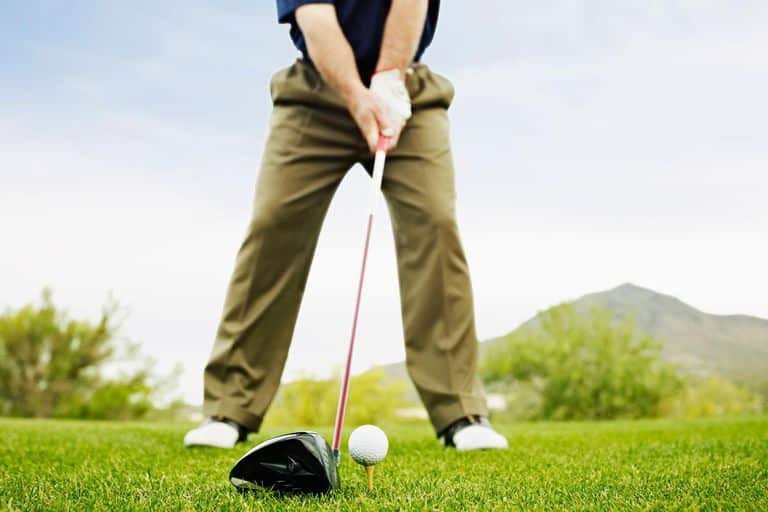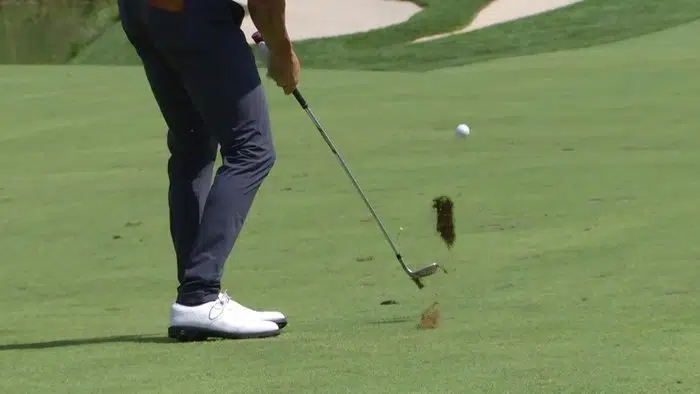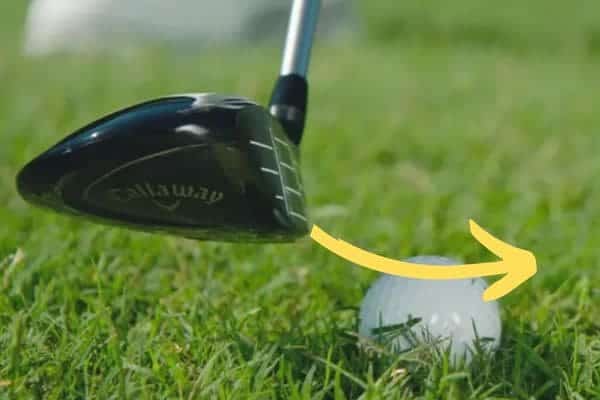Topping the ball is one of the most frustrating problems in golf.
It occurs when you make contact with only a fraction of the golf ball, the very top of it, meaning you clip it back into the ground rather than into the air.
This causes the ball to travel only a few dozen yards, sometimes less.
It can be extremely infuriating due to it not only being an unrewarding shot that barely gets you closer to the hole, but also because it’s quite an embarrassing problem to have and one that might make you feel like an amateur amongst your playing partners.
Topping the golf ball can also be extremely damaging if you play at a course with hazards to carry off the tee, or water and bunkers around greens, as a topped shot will no doubt lead to penalty strokes and lost balls.
So, how do you stop topping the golf ball?
To stop topping the golf ball, focus on getting your weight forward, as trying to hit the ball with too much weight on your back foot will cause a low point to occur too soon in the swing. This will cause you to make contact with the ball on the up, leading to thin or topped shots.
It is also important to focus on a stable head position and good leg movement to avoid coming up and out of your swing too early, making it less likely that you’ll hit the ball with a negative angle of attack, hence a topped shot being the result.
Keep reading as I’ll share some simple things to practice in order to stop topping the golf ball.
Table of contents
Why am I topping the golf ball?
The main reason you top the ball is because your swing has bottomed out too early, meaning you’ve hit the ball on the up, rather than compressing it properly. This can happen for several reasons including from standing up in the swing or poor weight transfer.
Often, people have real anxiety about hitting the ball fat or a poor theory of how to actually get the ball into the air.
Many golfers seem to unwillingly subscribe to the misconception that you have to physically scoop the ball into the air, rather than allowing the loft of the club to do the work for you when you’ve made a good swing.
If, for example, your swing comes too much over the top, your attack angle will be steep, causing you to hack deep divots from the ground.
You may pull off a good strike occasionally, but your tendency to hit shots heavy might lead you to remedying this through standing up in the swing to level out and shallow your arc.
This risks bringing topped shots into play, so working on a swing that comes more from the inside will help you to build confidence in taking a divot as an in-to-out swing should naturally be shallower.
Allowing too much weight to transfer onto the back foot, especially the outside of the back foot, in the backswing can be risky too, as it creates an additional movement required to ensure your arc doesn’t bottom out before the ball.
If you hang too much on the back foot then you could fat the ball, or even clip the ball on the way up and top it rather than compressing it with a downward strike.

How do you stop topping the golf ball off the tee?
To stop topping the ball off the tee you need to work on good rotation, avoid sliding your hips or hanging on the back foot in the downswing. With your irons and woods, you should feel as though you cover the ball a little more with your chest, while driver should feel as though your head stays behind the ball at all times.
Doing these things will help you make a neutral or downward strike on irons through to a 3-wood.
The driver is a little different, with a good transfer of weight onto the back foot and accentuated spine angle necessary, so topping the ball with the big stick could come down to something like your tee height being too low or even an angle of attack that is far too positive and on the up.
Hitting driver off the tee
Let’s explore the driver first as this is the club you’ll probably use more of off the tee.
While it is necessary to have a good spine tilt to promote and upward strike, going too far with this might mean the arc of your swing bottoms out too early with you only clipping the top of the ball by the time the clubhead reaches it.
A good cue to look for here is if you sometimes graze the ground with your driver a few inches before the ball, as this indicates your arc is bottoming out well prior to where it should be.
You may also stand up in your swing in an effort to launch the ball high into the air, but, again, this will just bring the club head up too early before impact meaning you connect with the top of the ball, so working on that in to out path is key here to make you feel less concerned about hitting down on your driver with an over the top swing.
While weight transfer is key with driver and a shift of weight into the back foot necessary, this does still need to transfer into the lead foot during the swing, so people that fail to do this could find themselves topping the golf ball as well.
While maintaining good posture, think about the weight moving into the inside of the back foot before transferring back into the lead foot as your downswing happens.
Hitting irons, hybrids and woods off the tee
When playing something like an iron or hybrid off of the tee, you should be looking for a negative angle of attack at impact, so taking a divot or at least scuffing the ground is key here to a good strike.
A poor understanding of the role loft plays in launching the ball into the air could be leading you to rise up and out of the swing, causing you to top the ball even if it is perched on a tee.
A simple drill like placing a head cover just outside of the ball or using a training aid like the JZ Golf Hook and Slice Corrector to help fix your path will assist you to come more from the inside in an effort to miss the head cover or barriers just outside of the ball.
Coming more from the inside will shallow your swing and make you fear taking a divot a lot less.

How do you stop topping the golf ball with irons?
To stop topping your irons you need to maintain posture in your swing, take a divot and don’t lift up towards the sky through contact. It’s important to feel as though your chest stays over the ball through impact to encourage compression. Shallowing your swing out will also help you stay low through the swing and drive the clubhead into the ground with confidence.
Maintaining a shallow swing can be difficult, as a steep, over the top swing is such a common flaw for many golfers.
I’ve tried to shallow my swing out in the downswing many different ways, but personally I have found the swing thought of keeping the hands close to the body through contact to be the easiest way to achieve this.
A simple little drill to get you driving that clubhead into the turf is to place a tee into the ground about an inch in front of the ball.
Push it right into the ground so it is only just poking up above the surface.
The challenge is to make sure you collect the tee and remove it from the ground when you play your shot.
This will encourage you to strike the ball first, then ground, with a descending angle of attack.
How do you stop topping the golf ball with fairway woods?
To avoid topping your fairway woods, it is crucial to rotate through your shot, rather than stand up and come out of the swing which will cause your clubface to be on the rise through the point of impact. This can be caused by a fear of ‘chunking’ down on the ball or believing that you need to lift the ball into the air.
Delofting the club can actually help reduce the likelihood of a topped shot too, as this will present more of the face and help create a downward angle of attack.
The underlying factor causing topped shots is often an over the top swing where the club is making its way down to the ball from a steep angle (steeper than the initial angle of the club shaft at address).
The brain is very good at realising this angle of attack is too steep and determines that when you make contact, you are probably going to hack down into the ground too deeply and struggle to lift the ball into the air.
So, what your brain does in this situation is tell your body to lift up and out of the shot to shallow the club, but this is very hit and miss and often causes the club to move through impact at a positive angle of attack, barely clipping the ball and topping the shot.
To fix this, you really need to work on rotating deeper and shallowing the club to remedy this fear of coming in too steep due to an over the top swing.
Once you shallow the swing out, you won’t be so scared of delofting your woods as the new swing path will promote a higher flight due to a more inside path.
This way, you can deloft the club in order to present the full face to the ball, meaning it’s a lot less likely you’ll collect it with the bottom of the club.
Drills to stop topping the golf ball
1. The split hands drill to shallow the club
To perform this drill, all you need is two simple steps. They are:
- Split your hands on the golf club so the trail arm (right arm for a right hander) sits a long way down the shaft
- At the top of your swing, practice pulling that right arm downwards into the slot (around a 45 degree angle to your target line) to flatten out the club
- Repeat this ‘pumping’ motion to get the feeling of shallowing the club into the correct position
Now, it might feel like this is silly given you don’t swing the club this way, but trying to develop an overaccentuated feel in practice will hopefully lead to a desirable middle ground during your actual swing.
By developing this shallower path, you’ll gradually train your mind that it is OK to stay low and grounded through impact, resulting in fewer topped shots.
2. Weight shift drill
Keeping too much weight on the back foot for too long can cause topped shots, so you really want to work on transferring weight into the lead side earlier in the swing.
A good drill is to make some small swings where the club only gets to parallel in the backswing.
From this parallel position, the first thing that should fire are the hips, starting to turn as weight is transferred into the lead side and foot, all happening before the club is allowed to move into the downswing.
This could be accompanied by a weight shift board to give clear feedback about when that transition is happening.
This drill will help train you to get the hips moving and weight transitioning into the lead foot so that you stop hanging back, avoiding a swing that shallows too early and only clips the top of the golf ball through impact.
Final message
Toping golf shots is about as embarrassing as it gets.
Nothing makes you feel more like an amateur than winding up a big fairway wood or drive just to top the ball a few yards.
Thankfully, developing a shallower swing can really help to eradicate those annoying tops, so working on a few drills at the range to improve your game should see a rapid correction of one of the nastiest habits in the game.


